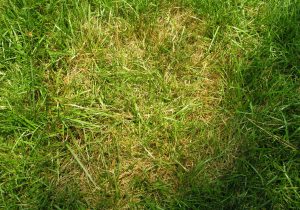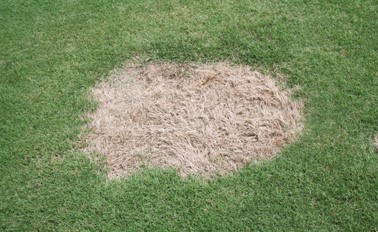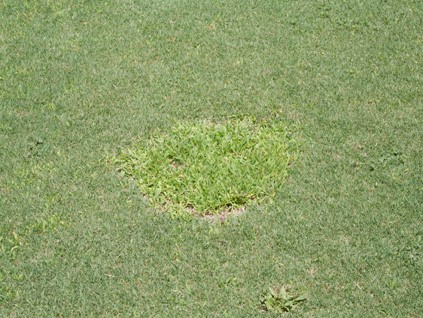Heather N. Kolich, ANR Agent, UGA Extension Forsyth County
Like flowers and holidays, lawn diseases predictably show up during certain seasons. In the spring, we may see dead spots during spring green-up.
Round patches of dead grass are signs the lawn is infected with fungi that cause Dollar Spot (Sclerotinia homeocarpa), Brown Patch and Large Patch (Rhizoctonia solani), or Spring Dead Spot (Ophiosphaerella spp). Fungicide applications can help manage the disease, but getting the diseases truly under control requires correcting environmental conditions and cultural practices that cause plant stress and encourage fungal growth.

Dollar spot affects both warm- and cool-season turfgrasses and may be active from February through December. It presents as small, sunken spots of dead grass – about the size of a silver dollar – that may be brown to tan in color. Georgia weather – warm days, cool nights, high humidity, and heavy dews – are favorable conditions for dollar spot to thrive, spread, and run together to create irregularly shaped areas of dead grass.
Although caused by the same fungal agent, brown patch affects cool-season turfgrasses while large patch hits warm-season turfgrasses. As with dollar spot, temperature, humidity, and prolonged leaf wetness set the stage for fungal growth.

Brown patch is active from February to June, and in November and December. The dead patches can measure up to 10 feet in diameter. Tan leaf spots with dark brown or black margins may be visible on leaf blades. The perimeters of brown patch circles may look brown.
Large patch attacks warm-season turfgrass as it begins to green-up in the spring and as it begins to enter dormancy in late summer or fall. The patches may persist in the same spot, increasing in size year after year and reaching up to 25 feet in diameter. The circle may look orange around the edges, where the newly affected leaf blades are. Blade death starts at the leaf tip and moves down the leaf sheath, where reddish-brown or black lesions may be evident.
New growth from the roots can occur with these three lawn diseases, but changes in environment and cultural practices that reduce plant stress are necessary to eradicate or reduce severity of the diseases. These changes include:
- Adjust soil pH to the optimal range for the grass species.
- Apply low to moderate amounts of nitrogen and don’t apply nitrogen when the diseases are active.
- On warm-season turfgrass, only apply nitrogen after active growth is strong in May, and make the last application of nitrogen in August. Later applications of nitrogen interfere with winter dormancy and can reduce winter hardiness.
- Increase cutting height.
- Reduce thatch (warm-season grasses) and increase air circulation to promote quicker leaf drying after dew and rainfall.
- Irrigate early in the day to reduce prolonged leaf wetness.
- Use core aeration during months of active grass growth to reduce soil compaction and improve drainage.

Spring dead spot is primarily a disease of bermudagrass, but can affect zoysiagrass, as well. Harsh winters and extended periods of freezing temperatures are factors in disease development and make this disease more common to North Georgia. The pathogen feeds on grass roots, rhizomes, and stolons, making the plants less able to survive severe or prolonged cold spells. Infection and root damage actually begins in the fall, when soil temperatures drop below 70 degrees Fahrenheit but stay above 50 degrees. The disease becomes apparent at spring green-up, when large circles of pale, dead grass show up. Because the roots are dead, grass does not recover within the dead areas. Weeds can move in, instead.

Selecting cold-tolerant bermudagrass cultivars is the first step in spring dead spot control. Next is getting a soil test and adjusting soil pH to a range of 5.8 to 6.2. Fertilize as recommended using acid-forming nitrogen and reduce nitrogen application as the dormant season approaches in late August. To improve winter hardiness, apply potassium (K₂O) in the fall in the amount indicated by a soil test report.
Improving soil condition isn’t as quick as applying a fungicide to the lawn. It can take several months to change soil pH, increase organic matter, and improve soil drainage. The final product, however, is healthier, more vigorous turfgrass and reduced need for pesticides in the landscape.